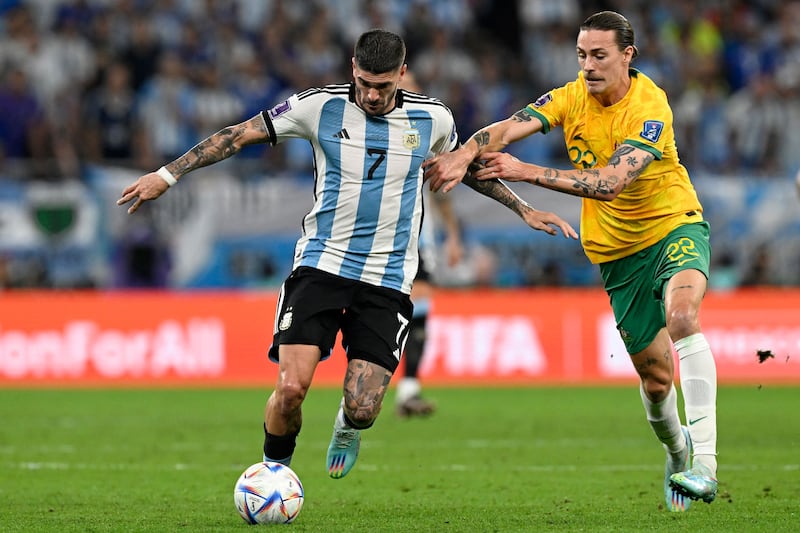Stopping Messi
For better or for worse, this was always going to be the tournament of Lionel Messi. If he fails to win the World Cup, the shadow lies across his career, a sense of destiny unfulfilled. If he wins, it is a glorious culmination. So far, no side have really been able to stop him and there’s a sense that, paradoxically, it is harder to know how to combat him now as he does less in games. For long spells he is not involved; it would seem absurd to man-mark him as Louis van Gaal had Nigel de Jong do in the 2014 World Cup semi-final; that would be to lose a player for the sake of three or four minutes in the game.
A major part of the problem is knowing where Messi will spring up. He will almost certainly be part of a front two, alongside Julián Álvarez. But he drifts on the periphery of the game, suddenly appearing, perhaps centrally, perhaps on the right, perhaps deep, perhaps high up. At various times, he will flit into the zones for which Theo Hernandez, Aurélien Tchouaméni and Adrien Rabiot (or Youssouf Fofana) are responsible.
But how you stop somebody such as Messi, who can confound a player as good as Croatia’s Josko Gvardiol with his dribbling, or split a defence with a preposterous pass that nobody else could have seen, let alone executed, as he did against the Netherlands? It may not be possible by tactical means.
Stopping Mbappé
Just as the first question for any side facing Argentina is how to stop Messi, so the first question any side facing France must ask is how to stop Kylian Mbappé. As with Messi, there is a sense that once he gets the ball, he can do almost anything, as his two goals against Poland demonstrated. But Mbappé, brilliant as he is, is a more conventional talent than Messi. His pace is his greatest asset, so one option is to sit deep against him and deny him space to run into, as Kyle Walker did in the quarter-final.
Argentina World Cup win not enough to knock Brazil off top of Fifa rankings
Argentina forced to swap bus for helicopters as fans swarm streets during parade
Qatar revels in tournament triumph — a lens on how the world works
World Cup 2022 knock-out stages: Your complete guide to the fixtures and results
But what Morocco showed in the semi is that Mbappé can be transformed into a (temporary) weakness. Achraf Hakimi took Mbappé on, surging down the right to link up with Hakim Ziyech. Only after Marcus Thuram had been introduced and Mbappé moved to the middle was that avenue closed down. Mbappé rarely tracked Hakimi and that left Hernandez, not the most natural defender, exposed.
Argentina’s Nahuel Molina is not an attacking right-back in the manner of Hakimi, but he was the recipient of Messi’s brilliant pass against the Netherlands; he can get forward. It’s a gamble, and it’s understandable why full-backs would be wary of deserting Mbappé, but at times it’s probably worth calling his bluff and trying to create overloads against Hernandez.
Hernandez v De Paul
Argentina could go to a back three. It was after dropping Guido Rodríguez between the centre backs Cristian Romero and Nicolás Otamendi that the game turned against Mexico, and Lisandro Martínez was brought off the bench to play as a third centre back against Poland, Australia and Croatia. Martínez also started as a third centre back against the Netherlands as Lionel Scaloni matched Van Gaal shape for shape. A back three could provide extra protection against Mbappé and, although Argentina have the personnel to compete in midfield, the problem, as it was for England when making a similar calculation, is that it reduces the threat to the vulnerable French full-backs.
So the likelihood is that the narrow 4-4-2 of the semi-final is retained. It’s possible if Ángel Di María is fully fit that he could be deployed wide, but more probable is that Argentina stick with the midfield they used against Croatia, when they looked more defensively secure than in any previous game. That means Alexis Mac Allister on the left and Rodrigo De Paul on the right.

De Paul’s role will be crucial, both supporting Molina in guarding against Mbappé, ideally cutting off the supply to him, and in trying to check Hernandez’s runs from full-back; Jules Koundé on the other side will not be so attacking from full-back, which means the Argentina four may be slightly lopsided, skewed to the right. If things go well, De Paul will also have a role in helping Messi to attack the space behind Hernandez.
Stopping Griezmann
Stopping France is not as simple as stopping Mbappé. France’s most threatening presence has probably been Antoine Griezmann. He has registered 3.5 key passes per game and three assists, including the devastating cross that brought Olivier Giroud’s winner against England. He’s also been making 2.8 regains per game, a remarkably high number for such a creative player. Somehow, Argentina have to restrict his influence.
Again the narrow 4-4-2 makes sense. Argentina should have an extra man to compete in that central area and look to crowd Griezmann out, while cutting off his route to Mbappé. Enzo Fernández has been one of the revelations of the tournament in that central role, capable both of defensive authority and moments of attacking inspiration, while alongside him Leandro Paredes is an aggressive, though holding midfielder.
The pair, who came together for the first time in the semi-final, look a very useful screen for a back four that has not been entirely convincing. At the same time, Mac Allister, another player who has grown as the tournament has progressed, can tuck in on the left.














